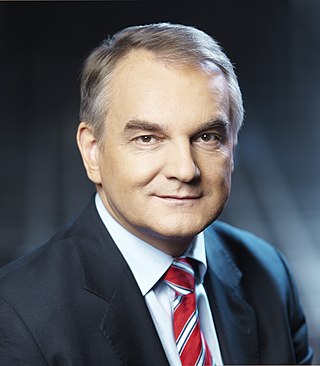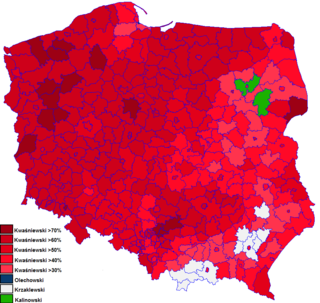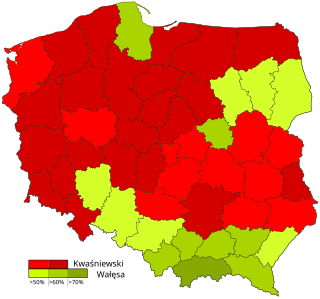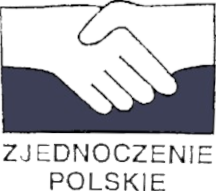Solidarity Electoral Action was a coalition of political parties in Poland, active from 1996 to 2001. AWS was the political arm of the Solidarity trade union, whose leader Lech Wałęsa, was President of Poland from 1990 to 1995, and the successor of the parties emerged from the fragmentation of the Solidarity Citizens' Committee.

The president of the Council of Ministers, colloquially and commonly referred to as the prime minister, is the head of the cabinet and the head of government of Poland. The responsibilities and traditions of the office stem from the creation of the contemporary Polish state, and the office is defined in the Constitution of Poland. According to the Constitution, the president nominates and appoints the prime minister, who will then propose the composition of the Cabinet. Fourteen days following their appointment, the prime minister must submit a programme outlining the government's agenda to the Sejm, requiring a vote of confidence. Conflicts stemming from both interest and powers have arisen between the offices of President and Prime Minister in the past.

From 1989 through 1991, Poland engaged in a democratic transition which put an end to the Polish People's Republic and led to the foundation of a democratic government, known as the Third Polish Republic, following the First and Second Polish Republic. After ten years of democratic consolidation, Poland joined NATO in 1999 and the European Union on 1 May 2004.

Lech Aleksander Kaczyński was a Polish politician who served as the city mayor of Warsaw from 2002 until 2005, and as President of Poland from 2005 until his death in 2010. Before his tenure as president, he previously served as President of the Supreme Audit Office from 1992 to 1995 and later Minister of Justice and Public Prosecutor General in Jerzy Buzek's cabinet from 2000 until his dismissal in July 2001.

Jan Ferdynand Olszewski was a Polish conservative lawyer and politician who served as the Prime Minister of Poland for five months between December 1991 and early June 1992 and later became a leading figure of the conservative Movement for the Reconstruction of Poland.

Waldemar Pawlak is a Polish politician. He has twice served as Prime Minister of Poland, briefly in 1992 and again from 1993 to 1995. From November 2007 to November 2012 he served as Deputy Prime Minister and the Minister of Economy. Pawlak remains Poland's youngest prime minister to date.

The Nonpartisan Bloc for Support of Reforms was an officially nonpartisan organization affiliated with Lech Wałęsa. It was established in 1993 and in 1997 became part of Solidarity Electoral Action.

Presidential elections were held in Poland on 8 October 2000. Incumbent President Aleksander Kwaśniewski was easily re-elected in the first round with more than 50% of the vote, the only time a direct presidential election in Poland has not gone to a second round.

Presidential elections were held in Poland on 5 November 1995, with a second round on 19 November. The leader of Social Democracy, Aleksander Kwaśniewski, and incumbent President Lech Wałęsa advanced to the second round. Kwaśniewski won the election with 52% of the vote in the run-off against 48% for Wałęsa.

Jan Krzysztof Bielecki is a Polish liberal politician and economist. A leading figure of the Gdańsk-based Liberal Democratic Congress in the early 1990s, Bielecki served as Prime Minister of Poland for most of 1991. In his post-political career, Bielecki served as president of Bank Pekao between 2003 and 2010, and served as the president of the Polish Institute of International Affairs between 2009 and 2015. Since the early 2000s, Bielecki has been a member of the Civic Platform party. In 2010, the Warsaw Business Journal described Bielecki as one of the most respected economists in Poland.

The Centre Agreement was a Christian-democratic political party in Poland. It was established in 1990 and had its roots in the Solidarity trade union and its political arm, the Solidarity Citizens' Committee. Its main leader was Jarosław Kaczyński. The party was initially the party of choice of Polish president Lech Wałęsa and heavily cooperated with him and his environment between 1990-1992, leading the first post-communist governments. In 1991, Jan Olszewski from Centre Agreement gained the support of Wałęsa for his candidacy for Prime Minister, forming a PC-led government. However, the government was mired with internal conflicts in 1992 and fell to a vote of no confidence. Afterwards, the party was increasingly marginalized and became a part of Solidarity Electoral Action in 1997. In 2001, leadership of the party dissolved Centre Agremeent to found Law and Justice, the direct successor of the party. However, it wouldn't be until a year later that it would dissolve.

The Center Civic Alliance, abbreviated as POC, was a center-right electoral alliance of several political parties that participated in the 1991 Polish parliamentary election. The Center Civic Alliance was chiefly organized by the Centre Agreement, drawing in remnants of the Solidarity Citizens' Committees, independents, and Christian right parties, including the Polish People's Christian Forum "Fatherland". The alliance was created after its main component, the Centre Agreement, attempted to form a broad alliance supporting President Lech Wałęsa. However, the alliance quickly fell out of favor with the president, failing to gain Wałęsa's approval. In its aftermath, Centre Agreement leader Jarosław Kaczyński was subsequently fired from his position as Chief of the Presidential Chancellery.
UOP Instruction nr 0015/92 was an internal instruction of Urząd Ochrony Państwa issued in October 1992, which allowed the illegal surveillance and, allegedly, the fomenting of the dissolution of those Polish political parties that were in opposition to the Cabinet of the then Prime Minister Hanna Suchocka or to President Lech Wałęsa.
Lustration in Poland refers to the policy of limiting the participation of former communists, and especially informants of the communist secret police, in the successor governments or even in civil service positions. Lustration, "cleansing", derives from Latin lustratio, a Roman purification ceremony. The first lustration bill was passed by the Polish Parliament already in 1992, but it was declared unconstitutional by the Constitutional Tribunal of the Republic of Poland. Several other projects were then submitted and reviewed by a dedicated commission, resulting in a new lustration law passed in 1996.

Lech Wałęsa is a Polish statesman, dissident, and Nobel Peace Prize laureate, who served as the president of Poland between 1990 and 1995. After winning the 1990 election, Wałęsa became the first democratically elected president of Poland since 1926 and the first-ever Polish president elected by popular vote. A shipyard electrician by trade, Wałęsa became the leader of the Solidarity movement, and led a successful pro-democratic effort, which in 1989 ended Communist rule in Poland and ushered in the end of the Cold War.
Cabinet of Jan Olszewski was the government of Poland from 23 December 1991 to 5 June 1992, sitting in the Council of Ministers during the 1st legislature of the Sejm. Led by lawyer Jan Olszewski, it was supported by the coalition of the Centre Agreement and the Christian National Union as well as the Party of Christian Democrats in the beginning and the Peasants' Agreement at the end.

Romuald Szeremietiew is a Polish politician, columnist, habilitated doctor of military sciences and associated professor at the Academy of National Defense and the War Studies Academy. He was a founding member of the Confederation of Independent Poland, an anti-communist, Sanationist independence movement. He became a member of the Sejm in 1997 and served as the Minister of National Defense in 1992 and Vice-minister in 1997.

The Movement for the Republic was a Christian-democratic political party in Poland. The party was founded by former members of centrist Centre Agreement who protested the downfall of Jan Olszewski and his cabinet from power. The party aspired to become the leading Christian-democratic party in Poland and contested the 1993 Polish parliamentary election, but it gained no seats as it failed to cross the 5% electoral threshold. The party was also mired by several splits and internal conflicts, which results in the party disintegrating into several smaller parties and formations. In 1995, Movement for Reconstruction of Poland founded by the party's first leader Jan Olszewski, absorbed most members of the party. The RdR dissolved in 1999.

The Centre Agreement – Polish Union was a Christian-democratic electoral alliance in Poland. It united the Centre Agreement (PC), Third Republic Movement (RTR), Christian-Democratic Labour Faction (ChDSP), Party of Fidelity to the Republic (SWR-KSN) and Regional Agreement RdR.

The Polish Union, also known as the Regional Agreement RdR in 1993, was a Christian-democratic centre-right political party in Poland. The party was founded by defectors from Polish Christian-democratic party Movement for the Republic, who left the party over the dispute regarding forming a possible coalition with Centre Agreement, the party that Movement for the Republic was itself a split from. Shortly after being formed, the Polish Union announced an electoral union with the Centre Agreement in June 1993, known as Centre Agreement – Polish Union.
















